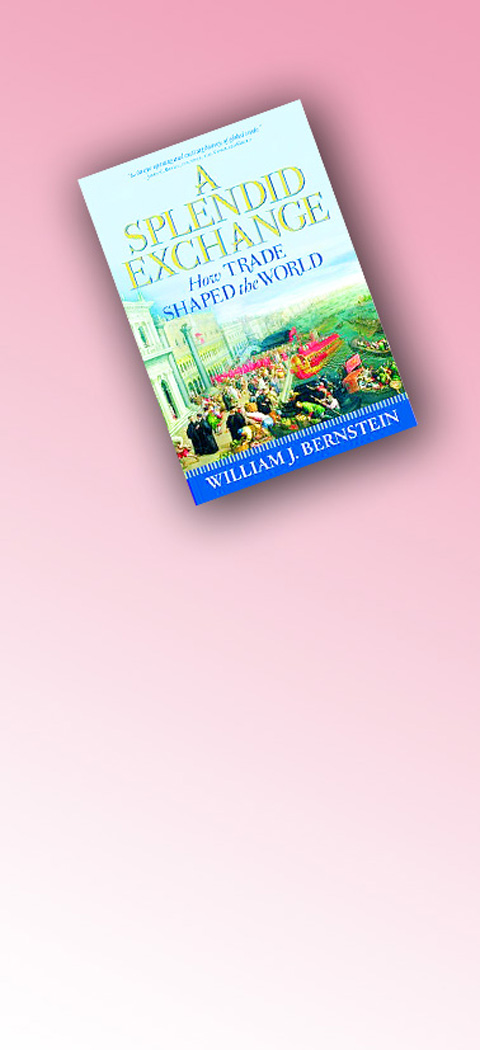In 2006 the world’s countries exported US$11.8 trillion in goods and services, far above the gross domestic product of any single country except the US, which itself exported over US$1 trillion worth. World trade has nearly doubled in less than a decade, and its increase since World War II is simply staggering.
The world is knit together as never before with a cat’s cradle of trade, which has already had immense consequences and will have many more. But while global trade has been much in the news lately, especially during this election year, it has an extremely long history. As William Bernstein makes clear in his entertaining and greatly enlightening book A Splendid Exchange, it has been a major force in driving the whole history of humankind.
Adam Smith explained in The Wealth of Nations that humans, and humans alone, are endowed with “a propensity to truck, barter and exchange one thing for another.” Equally important, skills and talents are not evenly distributed across the human landscape, nor are the world’s resources equally distributed across the natural one. Since humans also have a propensity to bash in one another’s skulls, we have always traded for what we wanted or raided for it. Bernstein’s book is a history of the first option, a refreshing view, to say the least.

Ancient Mesopotamia was richly endowed with fertile soils and water from the Tigris and Euphrates rivers, but it lacked stone and wood for building, and metals like copper for tools and weapons. The Sumerians, however, had surplus food to trade, so they could bargain for stone from near the headwaters of the rivers, wood from what is now Lebanon and metal from Sinai, Cyprus and elsewhere.
The scope of ancient trade was immense. A single Bronze Age shipwreck around 1350 BC near Bodrum, a Turkish coastal town, yielded no less than 9 tonnes of copper and a tonne of tin ingots along with other merchandise like ivory. (The ideal ratio of copper to tin for making bronze is 10-to-1.)
By Roman times vast armadas ferried Egyptian grain, Greek wine, Spanish copper and silver, and a hundred other commodities around the Mediterranean. India has yielded rich troves of Roman coins that reached that subcontinent to pay for spices the Romans coveted, especially pepper. Chinese silk — literally worth its weight in gold — traveled through the heart of Asia on the Silk Road to reach markets in the West.
As the West collapsed at the end of antiquity, so did its long-distance trade. Few Roman coins dating later than AD 180 are found in India, as the Roman economy began to run out of gold and silver. The Arabs came to dominate the major trade routes of the Indian Ocean after the rise of Islam. And as Western Europe revived economically, a lively trade developed between rising powers in Venice and the Middle East. (Venice supplied slaves from the Crimea and Caucasus in exchange for spices and sugar.)
When the Ottoman conquest of Constantinople slammed shut the sea route to the Crimea, Europe began seeking other routes to reach the resources of the East and eliminate the middleman. Columbus sailed west in 1492 and stumbled onto the New World. Vasco da Gama reached India in 1498, having rounded the southern tip of Africa. The modern world began, thanks to trade.
The history of global trade is so long and so vast that Bernstein could have easily produced a toe-breaker of a book. Happily he has not. By treating many aspects thematically rather than strictly chronologically, he shows in fewer than 400 pages of readable type how people and nations have faced the same problems over and over and often solved them the same way.
The poor soil and scant rain of ancient Greece, for instance, meant that the terrain’s ability to grow grain was limited, but grapevines and olive trees grew in abundance. To export its wine and olive oil, Athens developed a pottery industry to supply the jars in which those products were transported. As Greek trade, and colonies, flourished across the length and breadth of the Mediterranean and the Black Sea, naval power was needed to suppress piracy. To control choke points like the Dardanelles and Bosporus, which led to the rich grain lands of what is now Ukraine, the Athenian empire developed.
This succession of trade, colonies, naval power and empire repeated itself with the Venetians and Genoese, the Portuguese, the Dutch and the British. Even the strategic bottlenecks have stayed the same: Suez; the Strait of Hormuz leading to the Persian Gulf; the Strait of Malacca leading to East Asia; the Bosporus and Dardanelles. Only now, instead of slaves and spices flowing through them, it is oil.
Bernstein is a fine writer and knows how to tell a great story well. And he has many in this book, from Francis Drake’s voyage around the world (which repaid its backers, including Queen Elizabeth I, 50 pounds for every 1 invested) to the Black Death that remorselessly followed the trade routes as it worked its devastating way through Europe and the Middle East. But he never loses sight of his overall goal: to show how trade shaped the world in the past and will shape the world in the future, whether we like it or not.

The Democratic Progressive Party (DPP), Chinese Nationalist Party (KMT), and the country’s other political groups dare not offend religious groups, says Chen Lih-ming (陳立民), founder of the Taiwan Anti-Religion Alliance (台灣反宗教者聯盟). “It’s the same in other democracies, of course, but because political struggles in Taiwan are extraordinarily fierce, you’ll see candidates visiting several temples each day ahead of elections. That adds impetus to religion here,” says the retired college lecturer. In Japan’s most recent election, the Liberal Democratic Party lost many votes because of its ties to the Unification Church (“the Moonies”). Chen contrasts the progress made by anti-religion movements in

Last week the State Department made several small changes to its Web information on Taiwan. First, it removed a statement saying that the US “does not support Taiwan independence.” The current statement now reads: “We oppose any unilateral changes to the status quo from either side. We expect cross-strait differences to be resolved by peaceful means, free from coercion, in a manner acceptable to the people on both sides of the Strait.” In 2022 the administration of Joe Biden also removed that verbiage, but after a month of pressure from the People’s Republic of China (PRC), reinstated it. The American

Chinese Nationalist Party (KMT) legislative caucus convener Fu Kun-chi (傅?萁) and some in the deep blue camp seem determined to ensure many of the recall campaigns against their lawmakers succeed. Widely known as the “King of Hualien,” Fu also appears to have become the king of the KMT. In theory, Legislative Speaker Han Kuo-yu (韓國瑜) outranks him, but Han is supposed to be even-handed in negotiations between party caucuses — the Democratic Progressive Party (DPP) says he is not — and Fu has been outright ignoring Han. Party Chairman Eric Chu (朱立倫) isn’t taking the lead on anything while Fu

Feb 24 to March 2 It’s said that the entire nation came to a standstill every time The Scholar Swordsman (雲州大儒俠) appeared on television. Children skipped school, farmers left the fields and workers went home to watch their hero Shih Yen-wen (史艷文) rid the world of evil in the 30-minute daily glove puppetry show. Even those who didn’t speak Hoklo (commonly known as Taiwanese) were hooked. Running from March 2, 1970 until the government banned it in 1974, the show made Shih a household name and breathed new life into the faltering traditional puppetry industry. It wasn’t the first